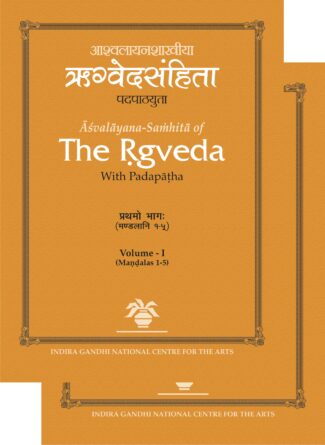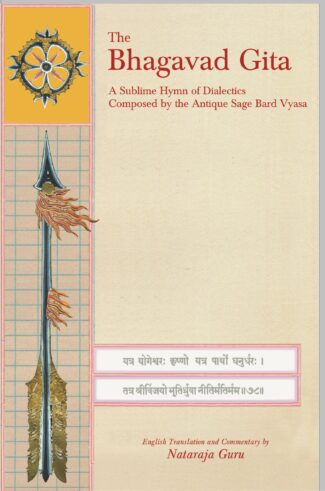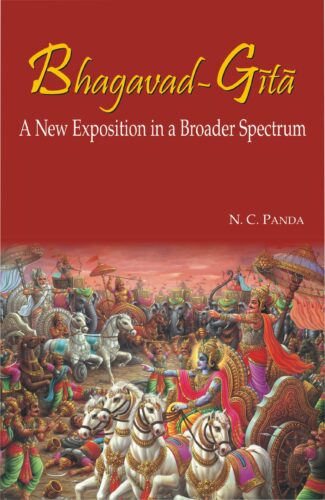Showing 1–10 of 132 results
The fascinating world of multiple Bharatas that this book introduces its readers with is that of a perennial tale discovered and created afresh at each juncture of time; at each moment of self-doubt and self-exploration; at each rejoicing of self-discovery and self-recovery. If one does not come across a seamless continuity here, one does not encounter apparent ruptures either. The Bharatas, as narrated here, present us with amazing diversity with palpable consubstantiality expressed in myriad forms and multiple hues; tradition belonging as much to its contemporaneity as to its past; belonging as much to the spokes as to the axle; centrifugal and centripetal at once; a tradition old and new at the same moment of time.
The book is based on the proceedings of a seven-day international conference organized by the Indira Gandhi National Centre for the Arts (IGNCA) on the living traditions of the Mahabharata in the year 2011. The conference explored the multiple tellings and retellings of the Mahabharata story as sung, danced, and celebrated in festivals, inscribed on to geographic landscapes, committed to memory as sacred genealogy, embodied in rituals, and sculpted in shrines and temples. The presentations ranged from issues of poetics and ethics to translations, adaptations, and variations to folk and tribal traditions as sung, recited, and performed. Rather than exploring the Mahabharata as a book or a singular narrative, these papers focus on the multi-tradition of the Mahabharata in all its multidimensionality, multiplicity, and above all, in its fluidity. The book would certainly interest the scholars engaged in the study of the living heritage of Indian epics, folklorists, indologists, and anthropologists.

This critical commentary offering fresh insights into the essential teachings of the Aitareya Upanisad presents its original Sanskrit text along with Roman transliteration and a verse-to-verse translation in English.
Yet another masterly piece of Hindu spiritual wisdom, Aitareya essentially reinforces the grand Upanishadic message which is neither a picturesque mythology nor a promise of heaven nor a threat of hell. It is yet another reminder (from the ancient seers) of our cosmic connection showing how this universe, this phenomenal world of ours, and all that is created, whether movable or immovable, are unfolded from one primeval casual Reality: atman, variantly called the Supreme Spirit, Pure Consciousness or Prajnanam Brahma; and how, in turn, atman perceives itself as the one underlying substance of all these phenomena. A distinguished exponent of Vedanta, Swami Muni Narayana Prasad reinterprets this Upanishad, developing refreshing insights into its textual discourse, its meaning, and its message. Also included in this critical commentary are its original Sanskrit text, Romanised transliteration, and verse for verse English translation. Appended to the Rigveda, Aitareya Upanishad comprises three chapters (IV-VI) of the Aitareya-Aranyaka which, in itself, is a continuation of Aitareya Brahmana. And as one of the principal Upanishads is invaluable as much to the discerning readers as to the scholars of Indian philosophy.

Re-dating and re-interpreting Manusmriti, possibly the oldest law work in the world, the book deals with aspects of Ancient India, including Aryan society and culture, castes and guilds, use of technology and related practices in the Indus Valley Civilisation. It also provides a look at other ancient law codes of the then known world and then compares them with the Manusmriti.
This is a fresh look at the history of Ancient India, centering on the Law Code of Manu (Manusmriti / Manu Dharmashastra), and its relationship to Rigveda and its possible relationship to the Indus/Harappan Civilisation of 4000 to 5000 years ago. It also throws light on Aryan society and culture, castes and guilds, use of technology and related practices in the Indus Valley Civilisation.
Dr. Charles Naegele, a practicing lawyer in Silicon Valley, California, USA, and a lifelong student of classical Indian knowledge, has written a work that will be certain to stir up controversy regarding the re-dating of the Law Code of Manu and the well-documented research concerning almost no possibility of Aryan Invasion Theory and the numerous similarities between the text of the Law Code of Manu and the archeological finds from the Indus/Harappan Civilisation.
Scholars and history buffs, as well as everyone who is proud of Indian heritage will enjoy not only this work, but also his future works.

This volume bears testimony to the fact that Indian sages, philosophers and scholars had a grip on all the topics that the modern-day scientists deal with, including complicated surgery and quantum mechanics. Our Vedas, Upanisads and other literary works were the storehouse of scientific wisdom, though the prevailing socio-religious conditions impeded its widespread dissemination.
The experiences and knowledge from our past are recorded in manuscripts which have been handed down to us over several thousand years. The Government of India, through the Department of Culture, took note of the importance of this vast tangible heritage and, in order to preserve and conserve as well as to make access to this wealth easy, established the National Mission for Manuscripts (NMM). In order to disseminate the knowledge content of manuscripts, the Mission has taken up several programmes such as lectures, seminars and workshops. The Mission has published the proceedings of the above-said programmes under the following series: Samraksika (on conservation), Tattvabodha (comprising lectures based on manuscripts delivered by eminent scholars), Samiksika (research-oriented papers presented in the seminars), Krtibodha (transcribed and edited texts prepared at advanced level manuscriptology workshops conducted by NMM) and Prakasika (publication of rare, unpublished manuscripts).
Ancient Indian Scientific Thought and Modern Theories makes one revisit the development of Indian science and technology in varied fields since the Vedic period, and suggests that we have a living tradition which is vivid and dynamic, inheriting at the same time claiming freedom from the past. It is the proceedings of a three-day seminar held during 25-27 March 2017 in Kolkata, organized by the Sanskrit Sahitya Parishad, Kolkata, and sponsored by NMM. This volume bears testimony to the fact that Indian sages, philosophers and scholars had a grip on all the topics that the modern-day scientists deal with, including complicated surgery and quantum mechanics. Our Vedas, Upanisads and other literary works were the storehouse of scientific wisdom, though the prevailing socio-religious conditions impeded its widespread dissemination.
This volume is expected to invoke keen interest among all who wants to know about a scientific past that Indians inherit, be a scientist or a layman.
आर्यभटीय प्राचीन भारत के महान् ज्योतिषविद् एवम् गणितज्ञ आर्यभट (476-550) की प्रमुख रचना है। आर्या—छन्द में रचित 121 श्लोकों से युक्त चार अध्यायों की आर्यभटीय भारतीय गणित एवम् खगोलिकी का एक सैद्धान्तिक ग्रन्थ हैए जिसका व्यापक प्रभाव मध्यकालीन भारत के अतिरिक्त अरब देशों में भी रहा।
आर्यभट ने सौर–मण्डल के भूकेन्द्रिक सिद्धान्त को प्रतिपादित किया हैए जिसमें सूर्य और चन्द्रमा अपने-अपने अधिचक्रों पर चक्कर लगाते हुए पृथ्वी का चक्कर लगाते हैं। ग्रहण के स्वरूप तथा उसकी गणना.विधि प्रस्तुत की गई है। वह पहले खगोलविद् रहे जिन्होंने पृथ्वी की अपने अक्ष पर भ्रमण करने की अभिकल्पना की है। दशमलव के चार अंकों तक पाई (π) का शुद्ध मान ज्ञात किया है। आर्यभट ने अंकों के प्रदर्शन के लिए अक्षरों का प्रयोग कियाए लेकिन इसकी क्लिष्टता के कारण यह प्रचलित नहीं हो सका। संख्याओं के वर्गमूल एवम् घनमूल ज्ञात करने की विधि या अनिधार्य समीकरणों के हल की कुट्टक विधि को आजकल क्रिप्टोलॉजी में आर्यभट एल्गोरिथम के रूप में प्रयुक्त किया जा रहा है।
डॉ˚ केदारनाथ शुक्ल द्वारा आर्यभटीय के संस्कृत श्लोकों का हिन्दी रूपान्तरण एवम् आधुनिक पदों में उनकी सरल व्याख्या प्रस्तुत करने का एक लघु प्रयास किया गया है। प्राचीन भारतीय गणित एवम् खगोलिकी की यह सर्वोत्कृष्ट कीर्तिए आशा हैए सुविज्ञ छात्रों एवं जन.मानस के लिए हितकर होगी।

The book, in two volumes, is a critical edition of the full text (with padapatha) of the Asvalayana-Samhita of the Rigveda. English and Hindi translations of the additional mantras of the Asvalayana-Samhita are also presented with the original Sanskrit verses.
Among the twenty-one Sakha-Samhitas of the Rigveda, as mentioned by Patanjali, only seven Samhitas were known by name and among these too, only one Sakala-Samhita was available in printed form so far. Now with the publication of the present editon of the Ashvalayana-Samhita a complete picture of a new Sakha-Samhita will come to fore for the first time. In comparison to the Sakala-Samhita, the Ashvalayana-Samhita has 212 additional mantras among which some occur in the common suktas and others form 16 additional complete suktas. Among these additional suktas special mention may be made of Kapinjala-sukta (II.44), Lakshmi-sukta (V.88-89), Pavamana-sukta (IX.68), Hiranya-sukta (X.130), Medha-sukta (X.155) and Manasa-sukta (X.171).
The book in two volumes presents the full text of the Ashvalayana Samhita of the Rigveda with padapatha, marked with proper accent marks. The additional mantras of the Ashvalayana Samhita followed by their translation in English and Hindi are also provided at the end of the Samhita text.
In a detailed introduction of the text the learned editor has examined the existence of Sakha-Samhitas of the Rigveda as mentioned by the Puranas, Patanjali, Mahidasa and other authorities, scrutinising textual evidence in support of them. The focus is, however, on the Ashvalayana-Samhita, with a background on Acarya Ashvalayana and exploring the antiquity, treatment of accent and padapatha of the text by referring to various sources.

Atmopadesa Sataka, mentioning one single principle, explains that mere virtue of gaining knowledge is not an end in itself. Its usefulness should be seen in the social, religious and veneration realms.
Atmopadesa Sataka, mentioning one single principle, explains that mere virtue of gaining knowledge is not an end in itself. Its usefulness should be seen in the social, religious and veneration realms.

Atreyashiksha holds a unique position in the corpus of the Shiksha literature. It shows that the main aim of the text is to explain the practical aspects of the different ways of Vedic recitation, in whose connection it describes the theoretical elements of Shiksha too. The phonological rules, most of which are expressed in the Taittiriya Pratishakhya, are also illustrated in this text.
Atreyashiksha is one of the Shiksha texts of the Krishna-Yajurveda, Taittiriya school. This text has been critically edited and translated consulting two palm-leaf manuscripts which are currently the only discovered manuscripts of this text in public libraries. Shiksha texts deal with phonetics and phonology of the Vedas and the method of proper pronunciation and recitation. The Atreyashiksha is well-structured in terms of arranging its topics of discussion.
When compared to the other Shikshas of the Taittiriya school, the Atreyashiksha, in keeping its focus on the discussion on the different methods of Vedic recitation, namely, word-reading (padapatha), sequential reading (kramapatha), tangled reading (jatapatha) and the five varieties of the reading of the phonic sequences (varnakramas), holds a unique position in the corpus of the Shiksha literature. A close reading of the text shows that the main aim of the text is to explain the practical aspects of the different ways of Vedic recitation, in whose connection it describes the theoretical elements of Shiksha too.
The book, therefore, serves as a practical guidebook to Vedic reciters who recite the above-mentioned readings of the Taittiriya Krishna-Yajurveda along with the continuous reading. While describing the methods of recitation, the Atreyashiksha gives enough emphasis on the theoretical nuances. The phonological rules, most of which are expressed in the Taittiriya Pratishakhya, are also illustrated in this text. This book consists of a detailed introduction, the critically edited text in Devanagari script, its Roman transliteration and an authentic English translation.

Standing tall in the field of Bhagavad Gita commentaries, this book is the result of the revolutionary treatment given by Nataraja Guru to this ancient masterwork of the human race to be appreciated as a universally applicable psychology of life and living.
Nearing its fiftieth year of being continuously in print, Nataraja Gurus monumental analysis of one of the greatest philosophical classics of Planet Earth is now available in a new edition. Generations have benefited from its unique angle of vision, which introduces a universal framework that does not depend on faith to impart its message of infinite potential for every human being. The Gurus wry humor, fresh insights, and fearless challenges to prevailing orthodoxies, are clear marks of his style. His analysis is radical by any measure, yet it must be noted that much of the scientific and philosophic community has evolved over the same half century toward a similar global, broad-minded outlook to the one which the Guru brings to bear in these pages, and which not coincidentally is advocated by the Bhagavad Gita itself.

This is an extraordinary volume on Bhagavad-Gita in that, besides the usual Sanskrit verses, their meanings and commentaries, this book covers all the eighteen chapters in the form of essays containing the reflections of the author who has analyzed the topic in the light of modern thought in a broader spectrum.
This Exposition on the Bhagavad-Gita is an exception to the traditional translation of and commentary on the scripture. It covers all the eighteen chapters of the Gita in the form of essays, with English translation of almost all verses and commentaries thereupon. In addition, the essays do contain the reflections of the author who has analyzed the topics in the light of modern thought in a broader spectrum. The Sanskrit text in Devanagari script, with Roman transliteration, has been appended to the main text.
The Gita is not a religious book. It does not belong to any single faith. In the language of Aldous Huxley, it is the perennial philosophy of mankind. Keeping this context in view, the book has been addressed not only to the present citizens but also to the whole mankind which will inhabit the earth in the future.
This scripture had its birth in a battlefield. Symbolically speaking, everybodys life is a battleground. Arjuna represents all members of the human species. In a situation of agony and dejection, being utterly perplexed, he could not decide what to do and what not to do. The Gita provides practical solutions to the problems of life and leads the path to liberation. It humanizes and divinizes man. The present book gets success if it helps man ascend humanely and spiritually.
| There are no products |